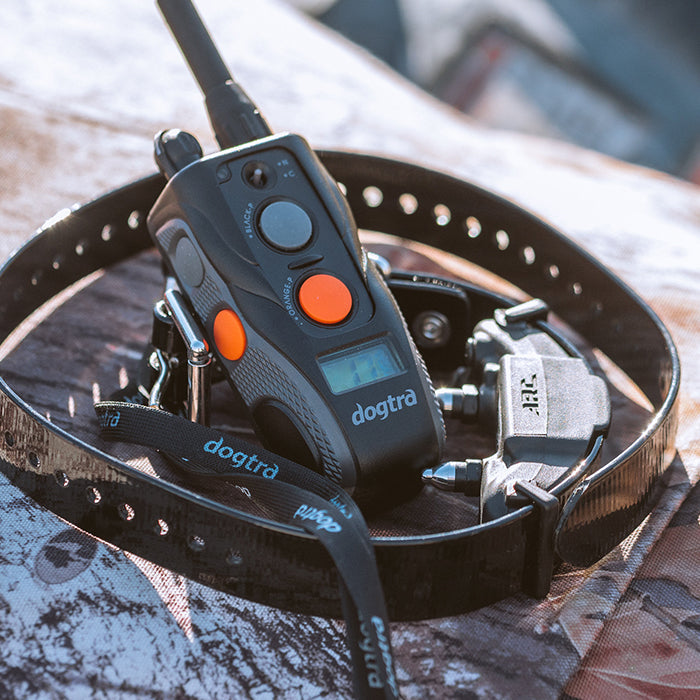Dogtra GPS Fence Flag Training Guide
To Get Started, Complete Each Step and Chapter Below
Need Help Navigating the Guide? Watch this Tutorial:
Need Help Navigating the Guide? Watch this Tutorial:
Chapter 1: Placing Flags
Placing Flags
The purpose of the flag is for your dog to have a visual indication to understand where the fence perimeter is located.
Step 1
Make sure you completed creating the virtual fence on the app. Once you have the perimeter set, it’s time to identify the virtual fence area and mark visual indicators, such as flags.

Step 2
Turn on the collar and set it to Tone, and carry the collar in your hand.

Step 3
Zigzag inwards and outwards of your drawn boundary to activate the Tone alert in order to identify the virtual fence perimeter. You won’t hear the Tone when you enter back for dog’s safety.

Step 4
Place flags roughly five feet inside the boundary, space them every eight feet apart along the perimeter. (Due to GPS signal drift, you do not want to place the flags right on the line.)

CONGRATULATIONS!
You have completed Chapter 1 of the training guide! Swipe below to continue and read more about Chapter 2.
Make sure to remove the collar before entering indoor spaces.

Chapter 2: Day 1-3
Introduce Your Dog to the Perimeter and Tone
The goal is for your dog to be able to see the flag in front of them when the warning tone sounds.
Step 1
Set the collar to Tone or Pager/Vibration only.

Step 2
With the dog on a short leash (6 ft long), Do not attach leash to GPS collar. Attach to flat collar.

Step 3
Start in the middle of the yard and walk towards the virtual fence perimeter

Step 4
Allow the dog to wander around the flags placed at various locations to trigger the collar, so it can hear the tone or feel the Pager/Vibration.

Step 5
Once the dog hears the tone, move toward the safe zone in the center of the yard. (away from the flags)

Step 6
Repeat step 5 and reward the dog with praise each time they respond correctly.
*Make sure to remove the collar when you enter the house. Wall and roof will block the GPS signal which can cause inadvertent correction.

CONGRATULATIONS!
You have completed Chapter 2 of the training guide! Swipe below to continue and read more about Chapter 3.
Make sure to remove the collar before entering indoor spaces.

Chapter 3: Day 3-7
Introduce the Correction Function
The goal is to introduce the correction function and have the dog associate the correction with the perimeter.
Step 1
At this stage, you should set the unit to the lowest level your dog can feel. This level can vary depending on your dog’s temperament and threshold for the correction. Level five is a common starting point. The level should be high enough so that your dog reacts, but not high enough that they vocalize or seem scared or nervous (See Training Tips #4 for more guidance on finding the right correction level).

Step 2
Repeat the training you did on ‘days 1-3’ with the dog on a short leash. Reward the dog with praise each time they respond correctly

Step 3
Allow your dog to feel the correction when the dog enters the virtual fence area.

Step 4
Once the dog feels the correction, guide them back toward the safe zone. Keep them on a short 6-foot leash as you continue teaching them to retreat to the safe area of the yard.

Step 5
Repeat step 5 and reward the dog with praise each time they respond correctly.
*Make sure to remove the collar when you enter the house. Wall and roof will block the GPS signal which can cause inadvertent correction.

CONGRATULATIONS!
You have completed Chapter 3 of the training guide! Swipe below to continue and read more about Chapter 4.

Chapter 4: Day 7-14
Teaching Avoidance
It is time to create more avoidance by increasing the correction level. The goal is that the correction level is now high enough to become a deterrent for crossing the virtual fence. Increase the level in increments of approximately five as needed.
Step 1
With the dog on a short leash (6 ft long), allow the dog to cross the virtual fence and receive a correction

Step 2
Leave the dog alone for a couple of seconds in an effort to have the dog figure out how to retreat from the correction and head back to the safe zone in the yard.

Step 3
If they do not retreat after a couple of seconds, help them by guiding them with the leash back to the safe zone.

Step 4
Repeat the exercise, and use lots of praise when the dog returns to the safe zone.
*Make sure to remove the collar when you enter the house. Wall and roof will block the GPS signal which can cause inadvertent correction.

CONGRATULATIONS!
You have completed Chapter 4 of the training guide! Swipe below to continue and read more about Chapter 5.

Chapter 5: Day 14-21
Working With Distractions
Once your dog can retreat to the safe zone by itself it is time to incorporate some common distractions they will see throughout their day.
Step 1
If your dog is doing well at this point, switch to longer leash/rope (20ft), let the dog drag the long leash/rope instead of you holding the leash. At this point, your dog should understand the virtual fence boundary and to return to the safe zone on their own when they feel the correction.

Step 2
Practice having a family member leave the yard while your dog is free, or practice tossing one of their toys past the virtual fence. Another good distraction is to have a friend walk their leashed dog past your property while you and your dog are in the virtual fence safe zone.

IMPORTANT
Have the dog drag the training leash/rope while you create distractions at an appropriate correction level for them.

IMPORTANT
Have the end of the rope near you at all time, should you need to guide the dog away from the virtual fence and back to the safe zone.

CONGRATULATIONS
You have completed Chapter 5 of the training guide! Swipe below to continue and read more about Chapter 6.

Chapter 6: Off-Leash Training
Off-Leash Training
This should be an easy transition, but it is important to monitor your dog closely.
Step 1
Should the dog test the virtual fence boundary, you will need to go back to the ‘Distraction training’ on the long leash/rope and potentially increase the correction levels.
*Make sure to remove the collar when you enter the house. Wall and roof will block the GPS signal which can cause inadvertent correction.

CONGRATULATIONS!
You have completed Chapter 6 of the training guide! Swipe below to continue and read more about Chapter 7.

Chapter 7: Flag Removal
Flag Removal
You can start removing flags once you are confident with your dog’s reaction to distractions
Step 1
The key here is to remove the flags slowly. Remove every other flag in the virtual fence and ensure your dog still respects the boundaries. After 2-3 days you can once again remove every other flag. Repeat this process until the flags are gone.
*Make sure to remove the collar when you enter the house. Wall and roof will block the GPS signal which can cause inadvertent correction.

CONGRATULATIONS!
You've finished the flag training guide!

Training Tips
Tip #1
It’s important to understand that all GPS-based collars may experience a small amount of GPS drift. This means the boundary line can naturally shift about 4 feet in either direction. Over time, your dog will learn the approximate location of the virtual fence, and the tone will serve as a warning when they get too close to the boundary.
Tip #2
Keep in mind that GPS collars can be affected by obstructions between the collar and the satellites. If you bought your collar during the winter, it is important to check the line in the spring once trees are fully leafed out to ensure the signal is reliable along the entire virtual fence boundary.
Tip #3
Fitting the collar properly is crucial! The collar needs to be snug enough that each contact point makes solid contact with your dog’s neck. If it is too loose or if there is too much hair in the way the collar will not work reliably. Dogs with thicker fur may require contact point extensions or you may need to trim their fur to ensure good contact.
Tip #4
Finding the right level for your dog is an important part of the process. When you introduce the stimulation/correction, your goal is to have it just high enough that your dog notices it. As you walk your dog towards the virtual fence, watch your dog closely for a sign of a reaction. Some dogs will move their ears back or slightly cock their head or tense neck muscles when they first feel the stimulation/correction. If they do not react, check the fit of the collar before increasing the level. If you are sure that the collar is fitted properly increase the stimulation/correction one level at a time until you see a reaction.
Tip #5
Don’t make a big deal out of putting the collar on or taking it off. You don’t want your dog to associate the collar with the fence. We want the dog to consider the boundary to be absolute, and associate the noise of the collar with the boundary, but not the collar itself.
Tip #6
Never pull or push the dog into the virtual fence area, we want them to wander into it on their own.
Tip #7
Remember that a virtual fence is not a substitute for behavioral training. If your dog is reactive/aggressive towards other dogs or people it is essential to specifically train on that issue rather than simply using a virtual fence. A reactive/aggressive dog is likely to run through a virtual fence after another dog regardless of the stimulation/correction level that the collar is set to.
Tip #8
Working with distractions is highly dog dependent. If your dog is excited by other dogs, it will take much more work to ensure they respect the stimulation/correction when another dog passes by your yard. If your dog is extremely ball or prey driven motivated it may take more repetitions/practice until you can throw a ball through the virtual fence and have them not chase. It is key to understand your dog and train according to their personality.
Tip #9
If you remove flags to mow the lawn, make sure to place them in the same location.
Tip #10
Should you need to take the dog out of the virtual fence, we recommend removing the collar. Then, either place the dog in your vehicle to drive past the virtual fence, or pick the dog up to physically carry over the virtual fence. By doing this, it will make it easier for your dog to understand the virtual fence is not to be crossed.
DISCLAIMER
If you must train them how to walk through the fence safely, use the following steps:
Always put your dog on a leash before exiting.
Make a big deal of putting on the leash, but do not make a big deal about taking off their fence collar. Teach them a word such as “Safe” that you use each time you take them out.
Choose one spot (driveway, specific gate etc.) where your dog will always exit - with a leash on the dog.
Your dog may be nervous to walk past the line at first, and may need a lot of praise and excitement from you.




